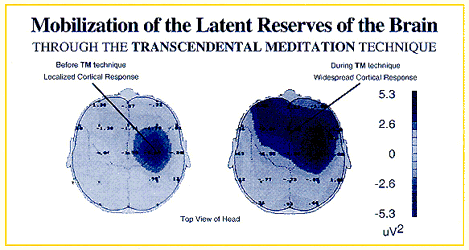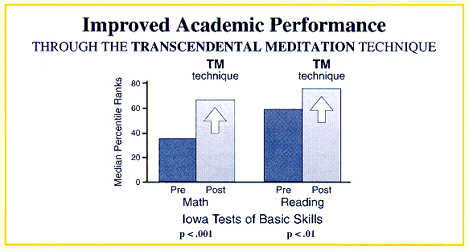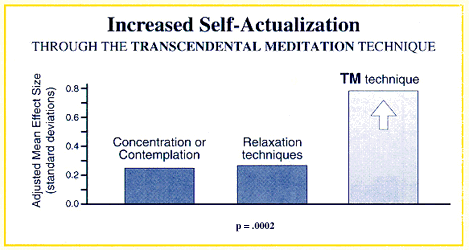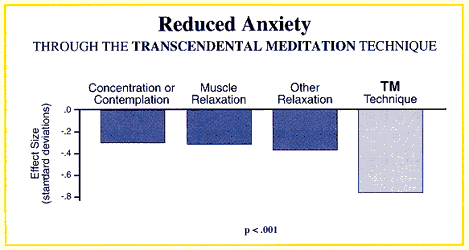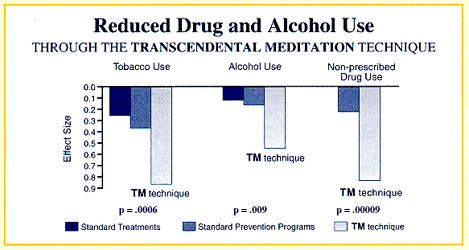Rehabilitation Studies
Psycho-social
Function in Inmates (topics)
In the first
published study using TM with inmates, 115 male, maximum security offenders at Folsom
State Prison in California were assigned to the TM group or to a control group (interested
in learning TM) so that both groups were homogeneous on all identifiable characteristics
including age, ethnicity, and security classification (Abrams & Siegel, 1978). Over a
three-month period, the TM group decreased significantly as compared to controls on
hostility, state and trait anxiety, insomnia, neuroticism, and behavioral infractions. The
experiment was then repeated with a second group of volunteer subjects and yielded
similar, significant results.
Another
study was conducted with 133 maximum security inmates at the Massachusetts Correctional
Institution at Walpole over a fifteen to seventeen-month period (Alexander, 1982).
Two samples of TM meditators decreased significantly
on aggression, trait anxiety, psychotic symptoms, and improved significantly on
Loevinger’s ego development scale compared to: a
wait-list control group interested in learning TM; a control group not interested in
learning TM; and members of four other rehabilitation programs (individual counseling,
group counseling, and two religious programs).
Ego
development typically does not change after 18–20 years of age or with the end of
formal education. Yet these maximum security inmates—26–29 years of age with a
ninth grade education—changed more, relative to controls, than any previously
observed adult sample. Ego development provides a relatively non-fakeable, comprehensive
measure of moral character, impulse control, cognitive functioning, and self-concept which
has been shown to predict lower re-incarceration rates among juvenile offenders.
Similar
results (including reduced rule infractions and increased participation in educational
and recreational programs) were shown in two three-month random-assigned studies and a
fourteen-month controlled study in Vermont inmates (Dillbeck & Abrams, 1987). In
Vermont, forty percent of the inmates and twenty percent of the correctional staff were
involved in the program during 1982 and 1983 (Gore, Abrams, & Ellis, 1991).
Recidivism Studies (topics)
The above effects on psychosocial functioning in inmates were
predicted to reduce subsequent recidivism (Alexander,
1982) . Over a 3.5 year period at Walpole, TM meditators recidivism rate was 33% lower
as measured by return to prison, and was 47% lower as measured by new conviction rate,
compared to random samples from the four other treatment groups, controlling for relevant
demographic covariates.
A study in the California Department of Corrections found that 259
male, felon parolees who had learned TM had 35–45% less recidivism from one to five
years after parole than closely matched parolees (Bleick & Abrams, 1987). In
contrast, prison education, vocational training, and psychotherapy did not consistently
reduce recidivism.
Case Study in the Entire Correctional System of
Senegal (topics)
A
large demonstration project conducted by Farrokh Anklesaria in
Senegal, West Africa showed even more dramatic results.
Between 1987 and 1989, the TM technique was taught to all inmates in thirty-one of
the thirty-four prisons; eleven thousand inmates and nine hundred correctional officers
practiced the TM technique regularly during the two-year project. This
project differed from those in the U.S. prisons in that all correctional officers
practiced the program, and all inmates practiced TM together.
This
comprehensive approach appeared to have a marked effect
on recidivism. The results were summarized in a letter from Colonel Mamadou Diop, Director
of the Penitentiary Administration: “...in Senegal usually about 90% of the inmates
released after serving their sentence come back to prison within one month. However, six
months after 2,000 meditating inmates were released in 1988, we could register less than
forty recidivists (a 2% return rate).... Considering that there is no structure or scheme
for the reintegration of inmates into society, nor is there any provision for work or jobs
for those released, it appears that the only possible explanation for this remarkable drop
in recidivism in our country is to be found in the application of your program.”
(Diop 1988 in Anklesaria, 1990).
Meta
Analysis on Substance Abuse (topics)
The link between drug abuse and crime is
well established. For example, 50% of state prison inmates were under the influence of
alcohol or drugs at the time of their offense (Bureau of Justice Statistics, 1993).
A recent meta-analysis of 198 studies
found that TM’s effects were significantly larger than those produced by standard
rehabilitation programs for treatment and prevention of three major classes of chemical
abuse—alcohol, cigarettes, and illicit drugs (Alexander, Robinson,
& Rainforth, 1994; cf., Gelderloos et al., 1991). Abstinence rates for standard
rehabilitation programs fall off substantially within three months of completing
treatment, with only 25% abstinent at one-year. In
contrast, TM abstinence rates were maintained or increased over the long-term, with
abstinence rates for these substances ranged from 51-89%
over a one to two-year period.
TM’s effectiveness in reducing drug dependence has been
linked to its reversal of the ravages of chronic stress. Walton and Levitsky (1994) argue that
chronic stress produces prolonged neuro-chemical imbalances which individuals attempt to
balance by ingesting chemicals. Drugs may produce short-term relief from distress, but in
the long-term create worse imbalances, distress and drug dependency. They suggest that TM
breaks the dependency cycle by optimizing physiologic homeostasis and psychological
well-being, thereby eliminating the need to take drugs.
Research on Changes Through TM Underlying
Rehabilitative Effects
(topics)
In contrast to more externally oriented
approaches to modifying attitudes and behavior, TM appears to promote this wide range of
rehabilitative changes through an inner process of psycho-physiological transformation.
Psychophysiological
correlates. Numerous experiments indicate that TM produces a distinctive state of restful alertness , a proposed fourth major state
of consciousness that can be distinguished from the ordinary states of waking, dreaming,
and sleep on over 20 psycho-physiological parameters (Alexander
et al., 1987). Deep physiologic rest
during TM (relative to eyes closed rest) is shown by significant decreases in respiration,
minute ventilation, blood lactate, and skin conductance (Jevning, Wallace, &
Beidebach, 1992). This profound rest is
predicted to normalize deep-rooted stresses associated with antisocial behavior (Maharishi, 1969).
Simultaneous enhanced alertness during
TM is suggested by increased alpha/theta EEG power and coherence, plasma arginine
vasopression, and faster H-reflex recovery (e.g., Badawi et al., 1984). Elevated
EEG coherence during TM significantly correlates with several parameters that have been
associated with positive rehabilitation, including higher moral reasoning, fluid
intelligence, grade point average, concept learning, creativity, and decreased neuroticism
(e.g., Orme-Johnson & Haynes,
1981).
It has been predicted (Maharishi, 1963) that chronic psychosocial
stress weakens mechanisms of physiological adaptation, thus undermining a person’s
well-being and ability to cope with a changing environment. As a result, propensity
towards antisocial means to satisfy desires increases.
Several studies have shown that TM
reduces stress-related biochemical and general physiological imbalances associated with criminal behavior. TM
participants (including prisoners and Vietnam veterans with post-traumatic stress
disorder) physiologically habituate more quickly to a series of stressful stimuli and
display a more stable autonomic response to stressors than matched controls (Brooks & Scarano, 1985; Orme-Johnson, 1973).
Also, the TM program has been shown to
decrease basal cortisol (a stress-related hormone) and increase serotonin availability and
turn-over during the practice and over the long-term.
This is relevant because research has demonstrated a relationship between low
serotonin, high basal cortisol, and impulsive aggression among violent criminal offenders
(Lidberg et al., 1985), and individuals
with aggressive personalities (Brown et al.,
1982).
Distinguishing TM from relaxation.
Do relaxation and meditation techniques differ in their effectiveness in producing
such positive outcomes? Several recent statistical meta-analyses, which
quantitatively summarize the results of hundreds of studies address this question. The TM
technique was found to:
1) reduce several indicators of
physiological arousal both during and after the practice compared to relaxing with eyes
closed (Dillbeck &
Orme-Johnson, 1987)
2) decrease chronic anxiety more than
other forms of stylized relaxation and meditation (Eppley, Abrams, & Shear,
1989)
3) enhance positive mental health as
operationalized by measures of self-actualization compared to other relaxation/meditation
practices (Alexander,
Rainforth, & Gelderloos, 1991).
In these meta-analyses, when such
factors as strength of experimental design, researcher bias, expectancy and treatment
length were controlled statistically, significant differences between groups were still
sustained.
Effects
of TM on Stress Disorders (topics)
Several studies have shown that TM reduces stress-related
biochemical and general physiological imbalances
associated with criminal behavior. TM participants (including prisoners and Vietnam
veterans with post-traumatic stress disorder) physiologically habituate more quickly to a
series of stressful stimuli and display a more stable autonomic response to stressors than
matched controls (Brooks & Scarano,
1985; Orme-Johnson, 1973).
Also, the TM program has been shown to decrease basal
cortisol (a stress-related hormone) and increase serotonin availability and turn-over
during the practice and over the long-term. This
is relevant because research has demonstrated a relationship between low serotonin, high
basal cortisol, and impulsive aggression among violent criminal offenders (Lidberg et al., 1985), and individuals with
aggressive personalities (Brown et al., 1982).
References
Abrams, A.I.
& Siegel, L.M. (1978). The Transcendental Meditation program and rehabilitation at
Folsom State Prison: A cross-validation study. Criminal
Justice and Behavior 5(1): 3–20.
Alexander, C.N. (1982). Ego
development, personality, and behavioral change in inmates practicing the Transcendental
Meditation technique or participating in other programs: A cross-sectional and
longitudinal study (Doctoral dissertation, Harvard University). Dissertation Abstracts International, 43(2), 539-B.
Alexander,
C.N., Cranson, R., Boyer, R., & Orme-Johnson, D.W. (1987). Transcendental
consciousness: A fourth state of consciousness beyond sleep, dreaming, and waking. Sleep and dreams: A sourcebook (pp. 282–315).
New York: Garland.
Alexander, C.N.,
Rainforth, M.V., & Gelderloos, P. (1991). Transcendental Meditation,
self-actualization, and psychological health: A conceptual overview and statistical
meta-analysis. Journal of Social Behavior and
Personality, 6(5), 189–247.
Alexander, C.N.,
Robinson, P., & Rainforth, M.V. (1994). Treating and preventing alcohol, nicotine,
and drug abuse through Transcendental Meditation: A review and statistical meta-analysis. Alcoholism Treatment Quarterly 11(1), 13–87.
Anklesaria, F. (1990). New Horizons in Criminology and Penitentiary Science:
The Maharishi Unified Field Based Integrated System of Rehabilitation in Senegalese
Prisons (p. 159). Vlodrop, Netherlands:
MVU Press.
Badawi, K.,
Wallace, R.K., Orme-Johnson, D.W., & Rouzere, A.M. (1984). Electrophysiologic
characteristics of respiratory suspension periods occurring during the practice of the
Transcendental Meditation program. Psychosomatic
Medicine, 46(3), 267–276.
Bleick, C.R. &
Abrams, A.I. (1987). The Transcendental Meditation program and criminal recidivism in
California. Journal of Criminal Justice, 15(3),
211–230.
Brooks, J.S. &
Scarano, T. (1985). Transcendental Meditation in the treatment of the post-Vietnam
adjustment. Journal of Counseling and Development, 64, 212–215.
Brown, G.L., Ebert, M.H.,
Goyer, P.F., Jimerson, C.D., Klein, W.J., Bunney, W.E., & Goodwin, F.K. (1982).
Aggression, suicide, and seratonin: Relationships to CSF amine metabolites. American Journal of Psychiatry 139, 741–746.
Bureau of Justice Statistics. (1993) Survey of State Prison Inmates, 1991. (p. 26).
Washington, DC: U.S. Department of Justice.
Dillbeck, M.C. (1990). Test of
a field theory of consciousness and social change: Time series analysis of participation
in the TM-Sidhi program and reduction of violent death in the U.S. Social Indicators Research, 22, 399–418.
Dillbeck, M.C.
& Abrams, A.I. (1987). The application of the Transcendental Meditation program to
correction. International Journal of Comparative
and Applied Criminal Justice 11(1): 111–132.
Dillbeck
, M.C. & Orme-Johnson, D.W. (1987). Physiological differences between
Transcendental Meditation and rest. American
Psychologist, 42, 879–881.
Eppley,
K., Abrams, A.I., & Shear, J. (1989). The differential effects of relaxation
techniques on trait anxiety: A meta-analysis. Journal
of Clinical Psychology, 45(6), 957–974.
Gelderloos
P., Walton, K.G., Orme-Johnson, D.W., & Alexander, C.N. (1991). Effectiveness of
the Transcendental Meditation program in preventing and treating substance misuse: A
review. International Journal of the Addictions, 26,
293–325.
Jevning,R.,
Wallace, R.K., & Beidbach, M. (1992). The physiology of meditation: A review. A
wakeful hypometabolic integrated response. Neuroscience
and Biobehavioral Reviews, 16, 415–424.
Lidberg, L., Tuck, J.R.,
Asberg, M., Scalia-Tomba, G.P., & Bertilsson, L. (1985). Homicide, suicide, and
CSF 5HIA. Acta Psychiatr Scand 71,
230–236.
Loevinger, J. (1976). Ego
Development: Concepts and Theories. San Francisco: Jossey-Bass.
Maharishi Mahesh Yogi.
(1963). The science of being and the art of
living. Los Angeles: International SRM.
Maharishi Mahesh Yogi.
(1969). On the Bhagavad-Gita: A new translation
and commentary. Harmondsworth, Middlesex, England: Penguin.
Maharishi Mahesh Yogi.
(1987). Life supported by natural law. Washington,
DC: Age of Enlightenment Press.
Orme-Johnson, D.W. (1973).
Autonomic stability and Transcendental Meditation. Psychosomatic
Medicine, 35, 341–349.
Orme-Johnson,
D.W. & Haynes, C.T. (1981). EEG phase coherence, pure consciousness, and TM-Sidhi
experiences. International Journal of Neuroscience,
13, 211–217.
Orme-Johnson,
D.W., Alexander, C.N., Davies, J.L., Chandler, H.M., & Larimore, W.E. (1988).
International peace project in the Middle East: The effects of the Maharishi Technology of
the Unified Field. Journal of Conflict Resolution, 32,
776–812.
Walton, K.G. &
Levitsky, D. (1994). A neuroendocrine mechanism for the reduction of drug use and
addictions by Transcendental Meditation. Alcoholism Treatment Quarterly, 11(1),
89–117.

